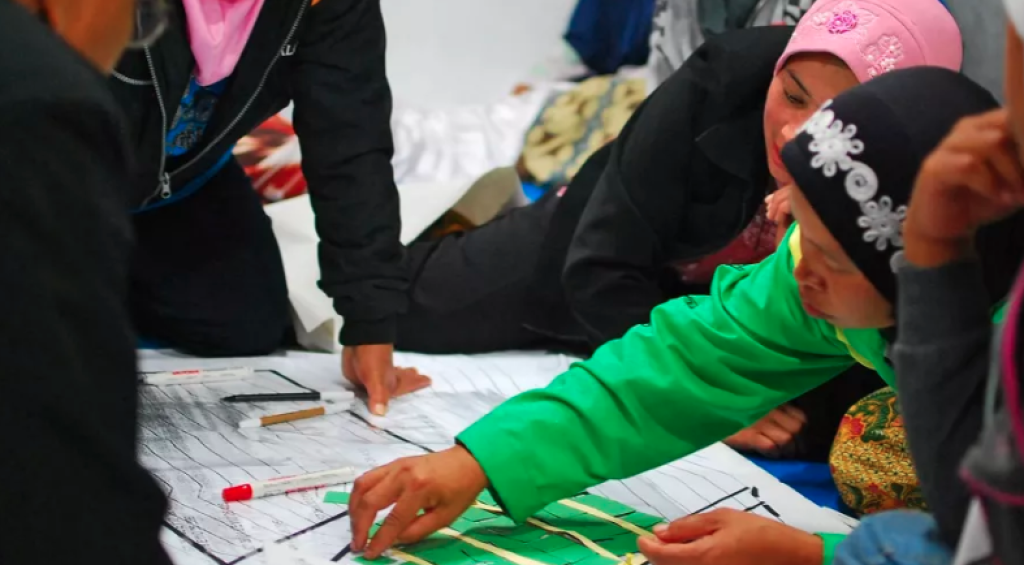Building and strengthening disaster and climate resilience is a collective effort. We need everyone to do their part. Yet existing barriers can prevent women, in particular, from fully contributing. This not only results in a loss for women but also for households and communities that are less able to protect themselves and recover from the impact of climate change.
Women are heavily affected by natural disasters and must play a crucial role in resilience and recovery. However, gender inequalities and norms often disadvantage them. For instance, women are often the primary caretakers in the family, a role which makes them more likely than men to miss work due to a shock. Missed work can lead to income loss, which can affect their ability to provide for themselves and their families; it can result in food insecurity and a lack of resources to rebuild their homes or businesses. In the aftermath of flooding in Dar es Salaam, 60% of those who reported missing work were women, and they also stayed home from work longer than men on average.
How can women be empowered to assume a greater role in resilience building? At the conference on “Understanding the Gender and Climate Nexus”, co-organized by the International Economic Association, the World Bank, and the United Nations Development Program, it was very clear that there is a major opportunity in recognizing and formalizing women’s role in disaster preparedness and recovery. Doing so would improve the resilience of communities and people and also yield co-benefits for gender equality in general, as work by the World Bank has shown.
Whether formally or informally, women always play an important role in disaster preparedness, response, and recovery efforts. However, when women are formally involved, the outcomes tend to be better, and their actions can have a transformative effect on the communities they serve. Women’s efforts benefit not only themselves but also the people who depend on them. That’s why the World Bank is actively working to close the gender gap in access to early warning systems and in the ability to respond to them. In Haiti and Bangladesh, the World Bank has involved women in outreach efforts and storm shelter management to combat hesitancy among women in using storm shelters due to safety concerns. This approach has had a positive effect on women’s disaster awareness and shelter use.
Post-disaster reconstruction often presents opportunities for people affected by disasters. However, as men typically benefit more from these opportunities, it is crucial to support the economic recovery of women. While setting targets for reaching women in livelihood support is essential, addressing the barriers that hinder their access to support is equally important. By understanding the gender dynamics and incorporating them in project design, better outcomes can be achieved, not only for women but for all. The case of Dominica, after Hurricane Maria, exemplifies how a livelihood restoration project focused on agriculture was used to support female farmers, who were among the worst affected by agricultural losses, as identified by a post-disaster needs assessment. The project went beyond merely targeting women, instead using women’s groups and associations to reach out to them. It provided separate trainings for female farmers, accompanied by childcare services, and covered topics of particular interest to women were covered.
Women have a critical role to play in building and strengthening climate resilience, and taking gender into account in program design can make such programs more efficient. But we need also to ensure that we do not involuntarily reinforce existing gender roles when we include them in how we design our interventions. For example, providing child-care options for female employees only may make a project more efficient, but also strengthen gender roles and inequalities, as it perpetuates the view that women are the main caretaker.
Instead, projects can be designed to generate long-term and transformational benefits for gender equality. The World Bank’s project, which supported Comoros’ reconstruction efforts after cyclone Kenneth in 2019, serves as a good example. Not only did the project address gender gaps in the context of disaster impacts, it also used the disaster context as an opportunity for transformational change. It engaged with the government on gender equality issues across many different areas, including women’s land tenure, participation in decision making and labor participation. The project made sure that female-headed households benefitting from the housing reconstruction component of the project, also received support to obtain a land title that made them legal owners. In community-level reconstruction of infrastructure, the project focused on women’s voice and agency and labor participation. It ensured that women’s feedback and concerns were reflected in the decision‐making around investments and targeted women in training and outreach activities to promote labor opportunities for women in infrastructure reconstruction.
There is overwhelming evidence that accounting for gender during the design, implementation, and monitoring of development interventions can lead to better development outcomes, both in the short and long term. However, there is still much that we do not know, and data on this topic remain scarce and hard to collect. Without reliable data, it is difficult to understand and address the specific needs and challenges faced by women and men in different contexts. Therefore, it is essential that we continue investing in building evidence, systematically collecting, and analyzing relevant gender disaggregated data. This is a necessary condition to be able to design effective policies and programs.
Source : World Bank



































































